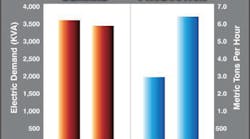The development of more powerful induction melting systems and the accompanying, widespread adoption of batch melting operations by foundries not only was the catalyst for automated charging systems, but it also led to many other types of automated systems in the melt shop and on the pouring lines.
Induction melting efficiency has increased to more than 98% and, though it’s unlikely to increase much more than that, the current technological standard provides unprecedented reliability and productivity, as demonstrated in this “real-world” example.
Batch melting is the process wherein the furnace is emptied after the metal has reached the proper temperature and successive melts are started using unheated or preheated solid charge materials. Although this process has always been typical of smaller induction systems, inherent design limitations and the lack of suitable power components prevented the manufacture of high-power, medium-frequency induction batch melting systems. As a result, virtually all large production requirements were handled by low-frequency, 50 Hz or 60 Hz heel melting units.
Heel melting is a process wherein molten metal is held in the furnace after tapping. Typically, this heel of metal is 10-15% of the furnace capacity. Although the best choice of equipment available at the time of their manufacture, these low-frequency heel melting systems imposed several significant operating limitations on the foundry, such as:
• The necessity of keeping a molten heel in the furnace between taps which meant that charge drying or preheating equipment had to be employed to reduce the risk of wet materials becoming introduced into the molten metal.
• The need to accept a larger-than-necessary furnace volume just to reduce the turbulent, low-frequency molten metal stirring activity rather than selecting the furnace volume best suited for the foundry requirement. Batch melting furnaces are always significantly smaller than heel melting furnaces operating at the same melt rate.
• The extra cost for electricity needed not only to keep the heel molten during the off shift but also to compensate for the greater heat losses of the larger furnace area. Comparable but physically smaller batch melting furnaces have significantly lower thermal losses and can be emptied and shut down after the pouring shift.
• The higher maintenance and component costs associated with, and required for, the larger heel melting furnace. There is a significant capital and maintenance (refractory) cost advantage enjoyed by the smaller batch melting furnaces.
• The extra cost to cast starter blocks used to reduce the long, cold start-up time which is characteristic of the heel melting design.
The first technological advance necessary to make high-volume batch melting a practical reality was the development of powerful, reliable, solid-state inverters for coreless induction furnaces. Line frequency (50 or 60 Hz) induction power systems that required a molten heel for melting could not be used for the batch melting process.
The early spark gap and motor generator units, first used to achieve frequencies above 60 Hz, were less than 75% efficient and, while able to effectively batch melt, could not achieve the high power levels needed for high-volume production melting.
Later systems, which multiplied line frequency magnetically, and the first solid-state power supplies were much more efficient but were still too small to make high-volume batch melting practical.
Early coreless induction batch melting equipment was best suited to small steel and investment casting foundries. Furnace size wasn’t the obstacle to greater production but applying power to the furnace was.
In early solid-state induction power supplies, power densities of up to 400 kW per ton were available in units able to track furnace loads and supply full power throughout the melting process. Power supplies of 500 kW were considered quite large.
The subsequent development of powerful, reliable, solid-state inverters incorporating “hockey puck” design SCR devices and “brick-type” design IGBTs made high-volume batch melting not only practical but also the most efficient way for many foundries to produce metal.
Now, medium-frequency power supplies providing 700 kW per ton are common and units able to apply 1,000 kW per ton are in operation at many foundries. Inductotherm alone lists more than 2,000 induction batch melting installations worldwide boasting power units of 2,500 kW or larger, applying up to 1,000 kW per ton of furnace capacity.
In fact, medium-frequency power supplies of up to 18,500 kW at 200 Hz are in operation, and there has been a solid-state unit providing 42,000 kW of induction power for heating massive steel slabs. Also, the efficiency of these units has increased from 85% in the 1970s to more than 98% today.
While it is not likely that tomorrow’s induction equipment will show further significant increases in electrical efficiency, what is proving meaningful to foundry operators, however, are today’s new levels of equipment reliability and utilization.
Satyen N. Prabhu is President and CEO of Inductotherm Corp.
Visit www.inductotherm.com









